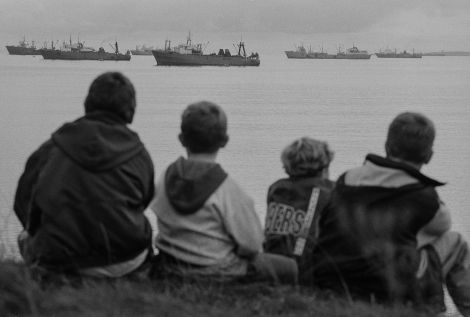News / Remembering the klondykers
A NEW book of photographs documenting the klondyker floating fish factories that visited Shetland in the 1990s has gone on sale.
Award-winning photographer Jeremy Sutton-Hibbert visited the isles in 1994 for two assignments to record the influx of Eastern European factory ships.
His limited edition 28-page book, published by Café Royal and available online, features images that give an insight into the lives of those who visited Shetland to work on the boats.
Glasgow-based Sutton-Hibbert, who has worked with the likes of The Guardian, the Sunday Times and Greenpeace, said he has numerous memories from his short trip to Shetland.
This includes inadvertently getting involved first-hand in a coastguard practice by getting lowered onto a moving boat.
“There were so many ships in the bay, so I wanted to get an aerial photograph,” he said.
“I phoned the coastguard to ask if I could come up in one of their helicopters to get a picture.
“To my surprise, they said sure – but the flip side of the deal was that they wanted to lower me onto a moving fishing boat for winching practice in exchange for the free flight.”
The klondyker period, which started in the 1980s and was centred around Lerwick, saw locals mix with a host of different cultures.
The bays around Lerwick were littered with the factory ships before they took supplies back to Eastern Europe.
It was an experience that Sutton-Hibbert, who has travelled the globe for work, says he will never forget.
“It was the period when communism had collapsed and Eastern Europe was opening up,” he said.
“To come to Shetland to see street signs in Cyrillic and people in all these foreign accents walking around – it was a fascinating time.
“I remember driving out to the garbage dump. A couple of ships had been impounded in the port and hadn’t been allowed back to sea, and the company weren’t paying the crews any wages.
Become a member of Shetland News
“You had all these guys in the Lerwick garbage dump looking for things they could refurbish to take home, or things they could sell.
“And I remember Shetlanders driving up and giving them packets of cigarettes, or bags of clothes and things. It was interesting to see that Shetlanders were rallying around to help them.”
The publication is part of a weekly photobook series from Café Royal, which is collected by the likes of St Andrews University. You can buy a copy here, and for more information on Sutton-Hibbert, visit his website.
The klondyker era came to an abrupt end shortly after Sutton-Hobbert’s visit with the sinking of three factory ships over a relatively short period.
Divers still visit the wrecks of the Pionersk and the Lunokhods, but the Borodinskoye Polye is too broken up and spread out around Lerwick harbour.
Become a member of Shetland News
Shetland News is asking its many readers to consider paying for membership to get additional features and services: -
- Remove non-local ads;
- Bookmark posts to read later;
- Exclusive curated weekly newsletter;
- Hide membership messages;
- Comments open for discussion.
If you appreciate what we do and feel strongly about impartial local journalism, then please become a member of Shetland News by either making a single payment, or setting up a monthly, quarterly or yearly subscription.





























































